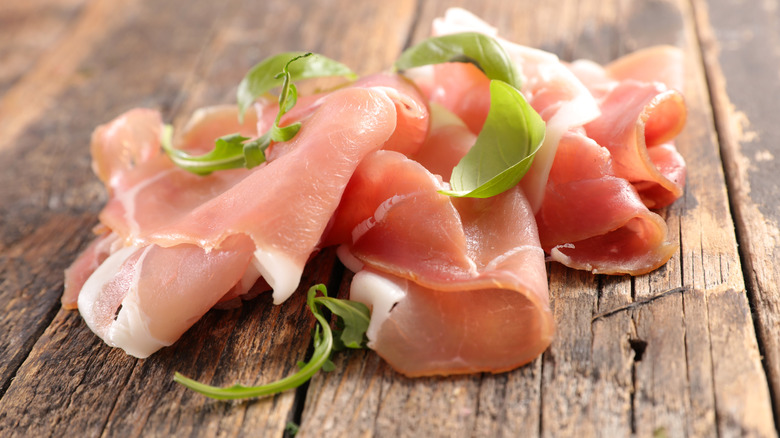The Prosciutto Rule You Never Knew About
If you've ever snacked on a charcuterie board or had an authentic Italian sandwich, you've probably eaten prosciutto. The thinly sliced, salty Italian meat is raw ham (pork) that is slathered in salt and undergoes a very extensive, drawn-out curing and drying process in order to get its uniquely complex taste, per Eat Cured Meat.
In fact, there's a rule about the meat you may not know: The drying process is so delicate that it takes a minimum of 12 months in a controlled temperature environment for the prosciutto to reach optimal taste. Albeit even then, the cured meat may not be ready. As with cheese and wine, the more aged it is, the better the taste.
According to Eataly, prosciutto was a byproduct of the pre-Roman times when Italian villagers had to "dry-age" meat so they had enough food to last them through the long, harsh winters. Refrigerators hadn't been invented yet so this dry-age technique spread like wildfire. Fast-forward to today, different regions throughout Italy have fostered their own prosciutto-producing technique, attracting locals and tourists from all over the world.
Prosciutto tastes best on pizza, pasta, and charcuterie boards
Also known as Parma Ham, prosciutto can be harder to come by in the United States and more expensive because it's an imported, high-quality good (via Parma Crown). If you're shopping for prosciutto, your best bet would be an Italian deli. Some Trader Joe's locations even sell it, too. In terms of dining out, most authentic Italian restaurants will offer it on the menu, and by "authentic," that doesn't mean Olive Garden or Macaroni Grill.
According to Eataly, one of the more common ways to enjoy prosciutto is on a charcuterie board with other dry cured meats, fruit (grapes and cantaloupe), bread, nuts, olives, different kinds of cheeses, crackers, and of course, always paired wine. Younger aged Parma Ham tastes best on pasta and pizzas, whereas longer-aged prosciutto is recommended for pairings or à la carte.
While prosciutto is deliciously addictive and easy to eat by the handful, it can be unhealthy. It's incredibly high in both fat and sodium, which can negatively affect your heart and potentially lead to high cholesterol levels, per Livestrong.com. Just be wary how often you're consuming prosciutto — moderation is key.

